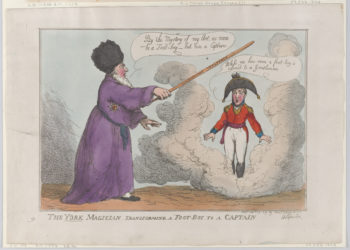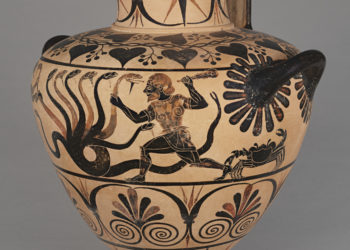In late August, Springer Nature and Germany’s Projekt DEAL announced that they had signed a memorandum of understanding (MoU) laying out the fundamentals of a national-level transformative open access agreement, whereby “more than 13,000 articles by German scholars and scientists are expected to be published open access (OA) per year, making them freely and immediately available to the world and increasing visibility and usage of German research published by Springer Nature.” I contacted Dagmar Laging, Springer Nature’s VP for Institutional Sales-Europe, who graciously agreed to answer some questions about this emerging deal.

How long ago did the discussions that led up to this deal begin, and what originally prompted them?
It has been nearly three years since we first started to have initial meetings with DEAL to see how we could work together to open up and advance the discovery of German-funded scientific research, which reflects the scale and complexity of what we were seeking to achieve. In addition, before negotiations with publishers could even start, DEAL needed to overcome huge internal hurdles in Germany due to the federal structure of the country which does not enable national agreements easily. Before DEAL was able to negotiate a national agreement, the alliance of German Research organizations and the Conference of Rectors of universities had to join forces and build a new type of national negotiation body. This was important as it was clear from the beginning that a shift to open access (OA) could only be successful on a national level, not on institutional or consortium level. That is what prompted DEAL – the political desire to move to OA as soon as possible and to overcome the structural hurdles within the country.
What goals did Springer Nature and the Projekt DEAL members have in common from the beginning, and on what issues did you need to seek compromise?
Springer Nature has a strong German publishing heritage and long-standing commitment to OA, and as such we are delighted to be partnering with Projekt DEAL in this way to make our shared goal of driving the sustainable shift towards OA even more of a reality. Our heritage and strength in OA publishing, coupled with DEAL’s position representing the majority of the most important science and research organizations in Germany, makes us natural partners to support German researchers and enable global access to German research results. But with not only transformative deals but the need to secure sustainable funding for fully OA equally critical to supporting the transition to OA, it was important to us and Projekt DEAL that any solution encompassed both hybrid journals and fully OA journals.
With a deal of this size there were understandably many things learned as both parties developed greater knowledge, understanding and appreciation of the other’s needs, and priorities and requirements for how these could be best addressed. However, neither of us allowed this to get in the way of achieving the final goal and we jointly believe that we have been able to agree a deal that will enable us to deliver the solutions that are best for science and the scholarly endeavor.
How is “open access” defined in the MoU? For example, will all affected articles be made available under a Creative Commons license (and if so, which version or versions of CC will authors be allowed to use)? Will embargoes be allowed at all?
Open access is not specifically defined in the MoU but at Springer Nature, the overwhelming majority (99% in 2018) of articles we publish Gold OA are published under a CC-BY license allowing full and immediate use and reuse.
Does the recently-signed MoU signal the end of the process, or do more terms remain to be negotiated? (If the latter, why the big public announcement now?)
This arrangement has taken time to finalize which reflects its scale and complexity. However, the shared belief, commitment and openness from both parties has meant we have been able to agree a solution which will enable scientists in Germany, whether from small or large institutes, whether from the hard or social sciences, to publish OA with us.
We are now happy to have reached an understanding on the model and commercial terms, and while we still have some details to work out, we felt it was important to let people know we expect to sign the agreement later this year. We are excited to be part of this unique cooperation and to play our part in a successful transition to open access in Germany.
How many journal titles in total are affected by this deal?
The Publish and Read element will be open to all Academic and Governmental institutions of Projekt DEAL (potentially more than 700 institutions), which means substantially enhanced access to Springer Nature content for the vast majority of the German research landscape. In fact, Springer Nature already implemented this enhanced access – in good faith – with the interim agreement in 2018.
The agreement will enable eligible authors to publish OA in Springer Nature’s collection of 1900 hybrid journals as well as in Springer Nature’s portfolio of over 600 fully open access journals, the largest OA portfolio in the world, including Nature Communications (the most cited OA journal), Scientific Reports, and BioMed Central flagship journals, as well as granting participating institutions permanent reading access to 1,900 journals in the Springer, Palgrave, Adis and Macmillan portfolios.
Now that it has been signed, is the MoU available for the public to read? (And if not, why not?)
As the MOU is not a legally binding document (and therefore potentially subject to change) we did not feel it was appropriate to make it public. Projekt DEAL will make the final contract, when signed, publicly available its website.
The press release expresses the expectation that “more than 13,000 articles by German scholars and scientists” will be made openly available by this deal. What percentage of Germany’s annual output of research articles does this represent?
Our analysis suggests that this will represent 15% of Germany’s annual research output which, coincidentally is the same as Springer Nature’s overall global market share.
The terms of the MoU seem quite complex — for example, some of the articles affected by this deal will be freely and permanently available to all, while others will be available only to members of “the academic community of the participating institutions” and only during the term of the agreement, and some core journals are excluded from the publish-and-read element of the deal entirely. Can you comment on this? Could this arrangement not have been a bit less baroque?
It isn’t actually that complex and simply follows how other such deals operate: articles published OA by authors at participating German institutions will be open to everyone around the world to read, use and reuse, while researchers at all German institutions will be able to access all articles in Springer Nature journals in the agreement regardless of whether they are published OA or not.
The Nature-branded subscription journals are not included as they currently do not offer a hybrid OA option.
Why is it that Springer Nature does not offer a hybrid OA option in the Nature-branded titles?
There are significant challenges for highly selective titles such as Nature to move to an OA publishing model. For example, our Nature-branded journals publish high quality scientific research, reviews and commentary which are selected and curated by in-house editors and offer high levels of author service. They also publish informative, accessible content beyond primary research – all of which requires considerable investment.
Further, highly selective journals, such as Nature publish far fewer articles compared with the number of submissions they evaluate (7% on average, meaning 14 submissions need to be evaluated for every article published), requiring greater editorial involvement and associated costs. In-house professional editors are fundamental to the Nature journals’ ability to offer outstanding author service.
Nevertheless, as we have stated in our recent proposal for transformative journals, our aim is to ensure that all researchers are able to publish in Nature-branded journals in the future and we are considering an OA publishing model that could also work for highly-selective journals.
Daniel Ropers of Springer Nature is quoted as saying that that this deal “enables scientists in Germany, whether from small or large institutes, whether from the physical, natural, applied or social sciences, and whether grant funding has been available or not, to publish with us.” But with an APC of €2,750 ($3,056), won’t many researchers be shut out — particularly those operating in fields that are less frequently and richly funded by grants?
The main feature of the agreement is that it gives corresponding authors from participating research institutions or universities, regardless of their academic discipline, the ability to publish OA in any of Springer Nature’s hybrid or fully OA journals or without having to worry about whether they have funds available to do so, thereby allowing for seamless OA publication for the term of the agreement without any limitation for the individual researcher and ensuring that no researcher will be shut out. This is a huge benefit for the individual researcher and one which sits at the heart of this agreement.
But to clarify, the €2750 is not an APC it is a “Publish and Read” (PAR) fee which reflects the costs for reading access and OA publishing in the Publish and Read (PAR) component and covers Springer Nature’s portfolio of some 1,900 hybrid journals.
Thanks for clarifying that. So what will be the mechanism for paying the “per-article PAR fee of €2,750” mentioned in the “key elements of the MOU” document on your website? Will it be paid by the libraries at participating institutions, or directly by the institutions themselves, or through the consortium? (Or by some other mechanism?)
Actually, DEAL and the MPDL [Max Planck Digital Library] Services as their operating body have arranged for a different mechanism. The payment for publishers will be arranged centrally through MPDL while MPDL will sign up the individual institutions for access and request payment from them directly. This can either come from the library or the research funds at a university and will require changes in funding streams at many institutions to happen over the next years. However, this is also one of DEAL’s declared aims – to re-arrange the payments for license fees in the past towards payments based on article output in the future.
Your press release indicates that the term of the agreement is for three years, “from 2020 to 2022 with an option to extend to 2023.” When it comes time to discuss an extension, what signs of success will you be looking for? Conversely, what red flags might lead you away from extending the agreement?
That is a difficult question to answer at this point in time. The publishing world – at least in Europe – has changed significantly over the past four years ago but as we have a very constructive and positive relationship with DEAL, evidenced by the agreement we have been able to reach, today is not the time to define red flags.
Fair enough, but setting aside the question of “red flags,” surely you can say something about what metrics of success you’ll be looking for. How will Springer Nature know whether this has been a deal that it should extend?
Naturally the main achievement for Springer Nat\ure will be to publish more articles from researchers in Germany than before. If we manage to develop our market share as publisher in Germany over the next years, the DEAL agreement will be considered as a success for us.
Discussion
6 Thoughts on "So What’s the DEAL?: An Interview with Springer Nature’s Dagmar Laging"
On reading this I was struck by the complete absence of any mention of the Humanities. I know that Projekt DEAL comes from the German Alliance of Science Organizations but thought that they are negotiating on behalf of all German academic institutions. Are Humanities researchers included in these agreements or are they limited to scientists?
Yes, humanities researchers are most definitely included in the agreement. That is what is so excellent about it – any researcher from a participating institution regardless of their academic discipline will be able to publish OA with us
This is a langue issue. “Wissenschaftler” in German includes all areas. We do not distinguish between “scientists” (which is the usual translation of “Wissenschaftler”) and “Humaities researchers”. To distinguish, one would say “Naturwissenschaftler” and “Geisteswissenschaftler” (and aditionally “Sotialwissenschaftler” = social scientists).
And like Dagmar Laging said, journals from all areas are included.
Thanks Rick for the opportunity to explain more about our agreement with Projekt DEAL. One thing I wish I had also mentioned, particularly in relation to the final question, is the increased usage of German research we are hoping will come from the deal. Our research shows that OA articles are cited more, downloaded more and have great broader impact ( as measured by Altmetrics). We very much look forward to the increased German research published by Springer Nature also benefiting from such increased visibility and usage
‘Naturally the main achievement for Springer Nat\ure will be to publish more articles from researchers in Germany than before. If we manage to develop our market share as publisher in Germany over the next years, the DEAL agreement will be considered as a success for us.’
Isn’ t it great: DEAL will help the big publishers to grow and win market share. Except for the DEAL negotiators the definition of success is different: less gets published with SN and promotion of none DEAL publishers. Unfortunately I don’t think that this is the case.



